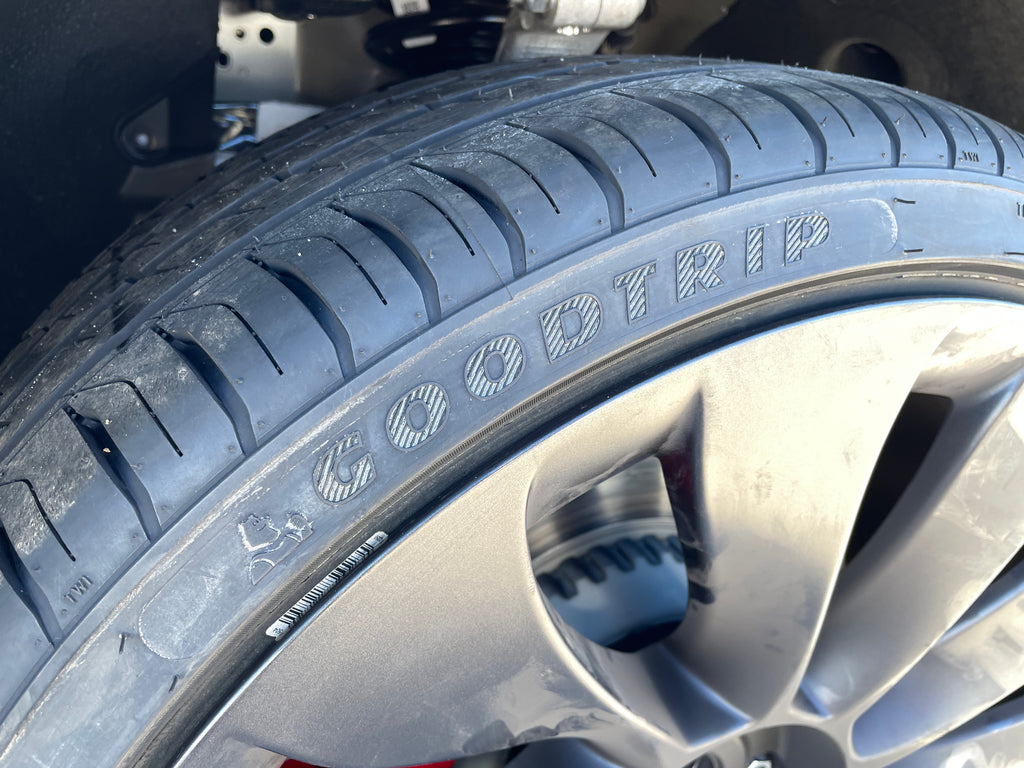When I last visited Thunderhill at the beginning of the year, I walked away with two major learnings: I need to figure out a better charging strategy and the car needed an upgrade to the brakes.
The weekend's event was being held on a track configuration known as "Thunderschleife". By connecting both the 2-mile West track and the original 3-mile East track at Thunderhill Raceway in Northern California, you end up with a "5-mile" layout combining two technical tracks for a very long lap. Though short of 5-miles and far short of the Nürburgring Nordschleife's 12.9 mile loop, Thunderschleife makes for a long and fun battery draining lap.

Charging
I was unable to source a CHAdeMO Adapter for purchase in time, but was able to rent a unit from a local Craigslist-er. We met at an EVGo charger to test it earlier in the week and I was then setup for Supercharging 34-miles away in Williams, CA, as well as 50kW charging just 7-miles away behind the Black Bear Diner in town. I woke up at the crack of dawn to Supercharge in Williams and trickle charged from the 240V 14-50 RV outlets. If I had woken up even earlier I could have started the session with a 90+% state of charge, but 85% SoC would have to do. By the end of the first session I was down to 57% SoC. This would have been fine for another session, but I headed to the EVGo Charge Station so I could see what the car could do.
Brakes
The stock brakes and tires on the 2022 Model 3 Performance are downright scary after a couple of laps. At the car's first track day I had at least switched the fluid to Motul RBF600, but the pads did not want to take the heat of stopping this beast. When swapping the rear pads out it seemed as if almost a third of the OEM pads were gone in just one track day. This made retracting the electronic parking brake to swap the pads quite the chore. The front OEM pads also looked like they were about to crack in to pieces.
On this day I was armed with a fresh set of G-LOC Brakes R12 brake pads in front and R10 brake pads in the rear. Having run this combination on other cars before I was not surprised at all by how well they performed. They had great bite, fantastic modulation, stopped hard, and gave me a new found confidence in the car. The G-LOC Brakes are a must-do upgrade for your Tesla track car. I was pleasantly surprised that the pads were also nearly silent on the way home from the track. I have the car's regenerative braking set to "HOLD" so this also definitely helped. Now that the brakes are servicable we can move on to tires.
Tires
If you have read up on Project Emotiv3 you will know it is a test bed and many things I might not normally want to do are done "in the name of science". I would have loved to have put fresh stickier tires on the car, but I wanted to see how the stock 235/35R20 tires would perform for the casual enthusiast just getting in to track days. The 2022 Model 3 Performance features 20" x 9" Uberturbine Wheels wrapped in Pirelli P Zero Elect tires. They are a 280tw tire and have a slight stretch for efficiency. They were not made for the track. At all.

I lowered cold pressures to 32 psi all around and after checking in the pits the tires were all pretty evenly at 38 psi. At 38psi the sidewall rollover looked alright. I never got around to getting tire pyrometer readings because I ran in to a small issue.

The stock tires have very little sidewall. VERY LITTLE SIDEWALL. Coming out of Turn 6W I had a slight off, dropping the right front wheel on the "start" of the right side rumble strip at the kink. This is a mistake that many have made over and over and over again, with fairly small reprecussions. In my case, I blew out the sidewall on the right front tire. I heard it clunk and was able to drive away, so I hoped for the best. But by the end of the West Track front straight I could tell I had lost the tire. I limped it back to the pits and assessed the damage.
Finding a 235/35R20 tire in the middle of nowhere Northern California is an exercise in frustration. I called over 10 shops to see if I could find any tire whatsoever so that I would not have to call for a tow or come back the next day with my trailer to get the car home. After what seemed like an hour of calling I finally found a no name tire with the correct size an hour away in Chico. Luckily, I had one of my best track buddy's there with me that day. A true friend who was willing to sacrifice a session and make the 2.5 hour round trip so I could drive home. The Goodtrip Tires (ironic, LOL) were noisy and shimmied the whole way home as the tech had trouble balancing them and I do not recommend them at all. I could not even find a website for these off-brand Chinese tires but I was thankful just to get home.

Data and Garmin Catalyst
At the end of the day, I put down a 3:41.36 with only 1.5 sessions. I am still getting used to the car and after reviewing the footage I can make the excuse that I did not have any clean laps, but this is all the data I have on it so I will mark it as so. For reference, fast drivers in FR-S/GT86/BRZ on street tires run mid-3:20s. I am still quite a bit off the pace. This was also the first time using the Garmin Catalyst camera and not just the unit, and I was overall very pleased with the footage. The ability to review video data right after the session is amazing and I cannot recommend this unit enough. If you are reading this from the San Francisco Bay Area, I will rent out the shop Catalyst™ for $50 for a track weekend. The setup is super easy, you just need to have an appropriate 12V power source. If you end up buying a Catalyst™ from the shop I will also apply the rental fee as a credit towards your purchase.
Edit: I forgot there was a little fun with a sideways DC-chassis Acura Integra. Here's a little video.
One of the biggest disappointments of the weekend was that I had not configured the in-car flash drive to collect Track Mode data. I am really beating myself up over this one. It is as simple as adding a folder named TeslaTrackMode to the drive. People pay thousands of dollars for data acquisition and having data like tire pressure, g's, brake temps, and power levels built in to the car are simply amazing. I will be working in the near future to see if this can be simply pulled off the CANBus via Raspberry Pi. A hacker's MoTeC C125, if you will.
Takeaways
The science experiment of running the OEM 20"s certainly blew up in my face. I have a set of 18" APEX EC-7 sitting here in the shop waiting to go on the car. Next comes the task of spending way too much time deciding on tires. For now, I am fairly happy with the way the stock suspension has performed. There is also a custom-valved set of KW Coilovers and other parts waiting to go on the car, but the planned modifications for the next track day science experiment are:
- 18x9.5" APEX EC-7 with a still undecided set of 200tw street tires - some actual performance tires should drop lap times by leaps and bounds.
- Mountain Pass Performance Brake Master Cylinder Brace - the brakes were vastly improved this outing and I would like to keep the calipers and rotors stock for as long as possible. This little brace should tighten up pedal feel a bit.
- Eibach 22mm Rear Sway Bar - I think the front OEM bar is big enough. Let's see how it feels with a little extra anti-roll in the rear.
-
TeslaTrackModefolder on the on-board recorder.
Despite the blown out sidewall I thoroughly enjoyed the day. At the end of our lives we will have nothing left but stories from way back when, and that is what we walked away with this weekend. The new G-LOC brakes were a great combo and I quickly learned the limits of the stock tires in a unique way. A huge thanks to Turn 8 Racing for hosting the day. I look forward to other events with them in the Model 3 Performance. Happy motoring!

